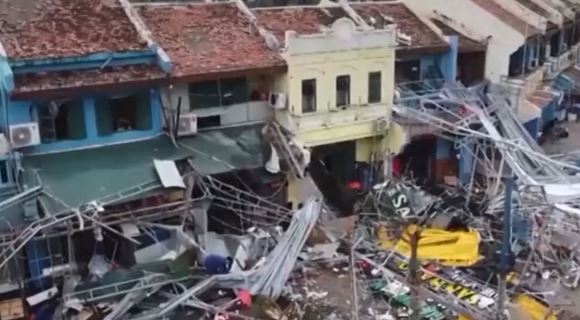Typhoon Yagi has left a trail of devastation in northern Vietnam, claiming the lives of at least 21 people and injuring more than 200, according to state media reports on Monday. The storm, regarded as one of the most powerful of 2024, unleashed torrential rain and fierce winds, causing widespread damage in the coastal province of Quang Ninh, where it made landfall on Saturday.
With wind speeds reaching up to 127 miles per hour, equivalent to a Category 3 hurricane, Typhoon Yagi brought destruction to homes and infrastructure. Local media reported the storm triggered deadly landslides, flooded towns, and tore roofs off homes across the region before weakening into a tropical depression by Sunday morning.
In addition to the heavy rain and winds, landslides caused by the storm added to the casualties. Among the victims were six people, including an infant and a one-year-old child, who were killed after a landslide swept through a residential area in Lao Cai Province, a mountainous region near Vietnam’s northern border with China. Another tragic landslide in Hoa Binh Province, located about 20 miles southwest of the capital, Hanoi, claimed the lives of four family members, state media reported.
The storm’s impact was felt across northern Vietnam, and by Sunday night, the death toll had risen to 21, according to the state-run news agency Vietnam News. The storm not only caused direct casualties but also led to extensive property damage, leaving many people without homes. At least 8,000 houses were reported to be damaged or destroyed, and many families were displaced, struggling to recover from the destruction.
The U.S. Navy’s Joint Typhoon Center, which had been tracking Typhoon Yagi, confirmed that after making landfall, the storm moved inland toward the country’s northwest highland region. The typhoon, which had already wreaked havoc in the Philippines and southern China earlier in the week, was expected to dissipate by Monday. In its last update on Saturday, the Joint Typhoon Center indicated that the storm was weakening but continued to pose a threat due to flooding and landslides.
In Hanoi, Vietnam’s capital, the storm caused significant damage, resulting in one fatality. Streets in the city were flooded, roofs were damaged, and widespread power outages left thousands without electricity. The heavy winds knocked over thousands of trees, including some of the city’s oldest and most iconic trees, which were considered landmarks, according to state media. The storm’s impact on Hanoi highlighted the vulnerability of even urban areas to the destructive power of Typhoon Yagi.
The coastal provinces of Quang Ninh and Hai Phong bore the brunt of the storm’s fury. In Quang Ninh, where the typhoon first made landfall, the majority of injuries were reported, with Vietnam News confirming that at least 229 people had been injured in the region. Many residents were injured by flying debris or collapsing structures, as the strong winds battered the province. Meanwhile, Hai Phong, a neighboring coastal province, also faced extensive damage, with homes, infrastructure, and crops destroyed.
The agricultural sector was hit particularly hard by Typhoon Yagi. Hundreds of thousands of acres of farmland, including rice paddies and fruit tree plantations, were damaged or flooded by the heavy rainfall. This could have lasting effects on the region’s economy, as farmers struggle to recover from the destruction of their crops. The full extent of the agricultural damage is still being assessed, but early estimates suggest that it could take months or even years for affected areas to recover fully.
Typhoon Yagi’s destructive path extended beyond Vietnam. Before hitting the country, the storm tore through the Philippines, where it claimed 20 lives. The storm also wreaked havoc in southern China, where it caused four fatalities and forced approximately one million people to evacuate their homes. In total, the typhoon has caused widespread destruction across multiple countries in Southeast Asia.
As relief efforts in Vietnam ramp up, authorities are working to assess the full scope of the damage and provide aid to the affected regions. Rescue teams have been deployed to assist those who were injured or displaced by the storm, while cleanup operations are underway to clear debris and restore infrastructure. The Vietnamese government has called for international assistance to help with recovery efforts, as the scale of the destruction becomes clearer.
The aftermath of Typhoon Yagi serves as a stark reminder of the dangers posed by powerful storms in the region. With climate change leading to more frequent and intense typhoons, countries like Vietnam are bracing for future storms and working to strengthen their disaster preparedness and response capabilities. For now, the focus remains on helping the survivors of Typhoon Yagi rebuild their lives and recover from the devastation left in its wake.

